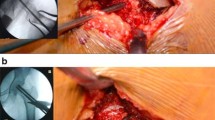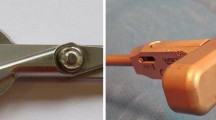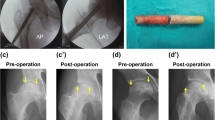Abstract
Introduction
Avascular osteonecrosis of the femoral head (AVN) is a widespread disease affecting mostly young and active people, often exacerbating in progressive stages, ending in joint replacement. The most common joint preserving operative therapy for early stages is core decompression (CD), optional with cancellous bone grafting (CBG). For success it is vital that the necrotic area is hit and the sclerotic rim is broken by drilling into the defect zone to relieve intraosseous pressure. The aim of this study was to investigate if both techniques are precise enough to hit the center of the necrosis and if there is a difference in precision between drilling with small pins (CD) and the trephine (CBG).
Patients and methods
10 patients underwent CD, 12 patients CBG with conventional C-arm imaging. Postoperatively 3D MRI reconstructions of the necrotic area and the drilling channels were compared. The deviation of the drilling channel from the center of the necrotic area was measured. PROMs (HHS, HOOS, EQ-5D, SF-36) were evaluated to compare the clinical success of these procedures.
Results
Neither with CD nor with CBG the defect zone was missed. The drilling precision of both procedures did not differ significantly: distance to center 3.58 mm for CD (range 0.0–14.06, SD 4.2) versus 3.91 mm for CBG (range 0.0–15.27, SD 4.7). PROMs showed no significant difference.
Conclusion
Concerning the most important difference between the two procedures—the surgical higher demanding technique of CBG—we suggest applying the less invasive technique of CD alone.




Similar content being viewed by others
References
Lieberman MR, Bery DJ, Mont MA, Aaron RK (2002) Osteonecrosis of the hip: management in the twenty-first century. J Bone Joint Surg 52:834–841
Koo KH, Lee JS, Lee YS, Kim KJ, Yoo JJ, Kim HJ (2006) Endothelial nitric oxide synthase gene polymorphisms in patients with nontraumatic femoral head osteonecrosis. J Orthop Res 24:1722–1728
Rader C (2007) Transient osteoporosis and osteonecrosis of the femoral head. Risk factors, classification and differential diagnosis. Orthopade 36:423–429
Houdek MT, Wyles CC, Martin JR, Sierra RJ (2014) Stem cell treatment for avascular necrosis of the femoral head: current perspectives. Stem Cells Cloning 7:65–70
Wang Y, Li Y, Mao K (2003) Alcohol-induced adipogenesis in bone and marrow: a possible mechanism for osteonecrosis. Clin Orthop Relat Res 410:213–214
Mont MA, Jones LC, Hungerford DS (2006) Nontraumatic osteonecrosis of the femoral head: ten years later. J Bone Joint Surg 88:1117–1127
Lee MS, Hsieh PH, Shih CH, Wang CJ (2010) Non-traumatic osteonecrosis of the femoral head – from clinical to bench. Chang Gung Med J 33:351–360
Li Y, Yue-Bai L, Yi-Sheng Y (2006) Dexamethasone-induced adipogenesis stromal cell cultures: mechanism of steroid-induced osteonecrosis. Chinese Med J 119:581–588
Lukoschek M, Simank HG, Brocai D, Strauch K (1999) Core decompression in osteonecrosis of the femoral head: risk-factor-dependent outcome evaluation using survivorship analysis. Int Orthop 23:154–159
Adekile A, Haider M, Marouf R (2005) HLA-DRB1 alleles in Hb SS patients with avascular necrosis of the femoral head. Am J Hematol 79:8–10
Craiovan B, Baier C, Grifka J, Götz J, Schaumburger J, Beckmann J (2013) Bone marrow edema syndrome. Orthopade 42:191–204
Kramer J, Scheurecker G, Scheurecker A, Stöger A, Huber A, Hofmann S (2009) Femoral head necrosis. Radiologe 49:410–418
Wang CJ, Wang FS, Huang CC, Yang KD, Weng LH, Huang HY (2005) Treatment for osteonecrosis of femoral head: comparison of extracorporeal shock waves with core decompression and bone grafting. J Bone Joint Surg 87:2380–2387
Aigner N, Petje G, Schneider W, Meizer R, Kotsaris S, Knahrl K et al (2005) Bone marrow edema syndrome of the femoral head: treatment with the prostacyclin analogue iloprost An MRI-controlled study. Wien Klin Wochenschr 117:130–135
Rajpura A, Wright A, Board T (2011) Medical management of osteonecrosis of the hip: a review. Hip Int 21:385–392
Li X, Xu X, Wu W (2014) Comparison of bone marrow mesenchymal stem cells and core decompression in treatment of osteonecrosis of the femoral head: a meta-analysis. Int J Clin Exp Pathol 7:5024–5030
Roth A, Beckmann J, Bohndorf K, Fischer A, Heiss C, Kenn W et al (2016) S3-Guideline non-traumatic adult femoral head necrosis. Arch Orthop Trauma Surg 136:165–174
Adrian F, Deepak B, Riyaz J, David H (1994) Long term results of core decompression for ischemic osteonecrosis of the femoral head. J Bone Joint Surg 76:42–49
Simank HG, Brocai DR, Strauch K, Lukoschek M (1999) Core decompression in osteonecrosis of the femoral head: risk-factor-dependent outcome evaluation using survivorship analysis. Int Orthop 23:154–159
Rocchi M, Del Piccolo N, Mazzotta A, Giavaresi G, Fini M et al (2020) Core decompression with bone chips allograft in combination with fibrin platelet-rich plasma and concentrated autologous mesenchymal stromal cells, isolated from bone marrow: results for the treatment of avascular necrosis of the femoral head after 2 years minimum follow-up. Hip Int 30:3–12
Hernigou P, Gerber D, Auregan JC (2020) Knee osteonecrosis: cell therapy with computer-assisted navigation. Surg Technol Int 36:281–287
Martinot P, Dartus J, Justo A, Riouach H, Cremer P et al (2020) Does augmented core decompression decrease the rate of collapse and improve survival of femoral head avascular necrosis? Case-control study comparing 184 augmented core decompressions to 79 standard core decompressions with a minimum 2 years’ follow-up. Orthop Traumatol Surg Res 106:1561–1568
Kang JS, Suh YJ, Moon K, Park JS, Roh TH et al (2018) Clinical efficiency of bone marrow mesenchymal stem cell implantation for osteonecrosis of the femoral head: a matched pair control study with simple core decompression. Stem Cell Res Ther 9:274
Beckmann J, Goetz J, Baethis H, Kalteis T, Grifka J, Perlick L (2006) Precision of computer-assisted core decompression drilling of the femoral head. Arch Orthop Trauma Surg 126:374–379
Learmonth LD, Maloon S, Dall G (1990) Core decompression for early atraumatic osteonecrosis of the femoral head. J Bone Joint Surg 72:387–390
Beckmann J, Tingart M, Perlick L, Lüring C, Grifka J, Anders S (2007) Navigated drilling for femoral head necrosis experimental and clinical results. Orthopade 36(4):58–465
Ficat R (1985) Idiopathic bone necrosis of the femoral head. J Bone Joint Surg 67:3–9
Beckmann J, Schmidt T, Schaumburger J, Rath B, Lüring C, Tingart M et al (2012) Infusion, core decompression, or infusion following core decompression in the treatment of bone edema syndrome and early avascular osteonecrosis of the femoral head. Rheumatol Int 33:1561–1565
Sallam A, Imam M, Salama K, Mohamed O (2017) Inverted femoral head graft versus standard core decompression in nontraumatic hip osteonecrosis at minimum 3 years follow-up. Hip Int 27:74–81
Koo KH, Ahn I, Kim R, Song HR, Jeong ST, Na JB et al (1999) Bone marrow edema and associated pain in early stage osteonecrosis of the femoral head: prospective study with serial MR images. Radiology 213:715–722
Tripathy S, Goyal T, Kumar R (2015) Management of femoral head osteonecrosis: current concepts. Indian J Orthop 49:28–45
Kaushik A, Das A, Cui Q (2012) Osteonecrosis of the femoral head: an update in year 2012. World J Orthop 3:49–57
Funding
Each author certifies that there are no funding or commercial associations (consultancies, stock ownership, equity interest, patent/licensing arrangements, etc.) that might pose a conflict of interest in connection with the submitted article related to the author or any immediate family members.
Author information
Authors and Affiliations
Corresponding author
Ethics declarations
Conflict of interest
The Authors declare that there is no conflict of interest. This research received no specific grant from any funding agency in the public, commercial, or not-for-profit sectors.
Ethical approval
This study was conducted after authorisation by the Institutional Ethical Board of the Medical University of Regensburg (No. 14-101-0108). It has been performed in accordance with the ethical standards in the 1964 Declaration of Helsinki and has been carried out in accordance with regulations of the US Health Insurance Portability and Accountability Act (HIPAA). Written informed consent for participation in this investigation was obtained from all patients.
Informed consent
Written informed consent for participation in this investigation was obtained from all patients.
Additional information
Publisher's Note
Springer Nature remains neutral with regard to jurisdictional claims in published maps and institutional affiliations.
The work was performed at University Hospital Regensburg, Department for Orthopaedic Surgery, Bad Abbach, Germany.
Rights and permissions
Springer Nature or its licensor (e.g. a society or other partner) holds exclusive rights to this article under a publishing agreement with the author(s) or other rightsholder(s); author self-archiving of the accepted manuscript version of this article is solely governed by the terms of such publishing agreement and applicable law.
About this article
Cite this article
Woerner, M., Voelkl, K., Ferner, F. et al. Avascular necrosis of the femoral head: three-dimensional measurement of drilling precision reveals high accuracy and no difference between fluoroscopically controlled core decompression and cancellous bone grafting. Arch Orthop Trauma Surg 143, 4713–4719 (2023). https://doi.org/10.1007/s00402-022-04753-2
Received:
Accepted:
Published:
Issue Date:
DOI: https://doi.org/10.1007/s00402-022-04753-2




